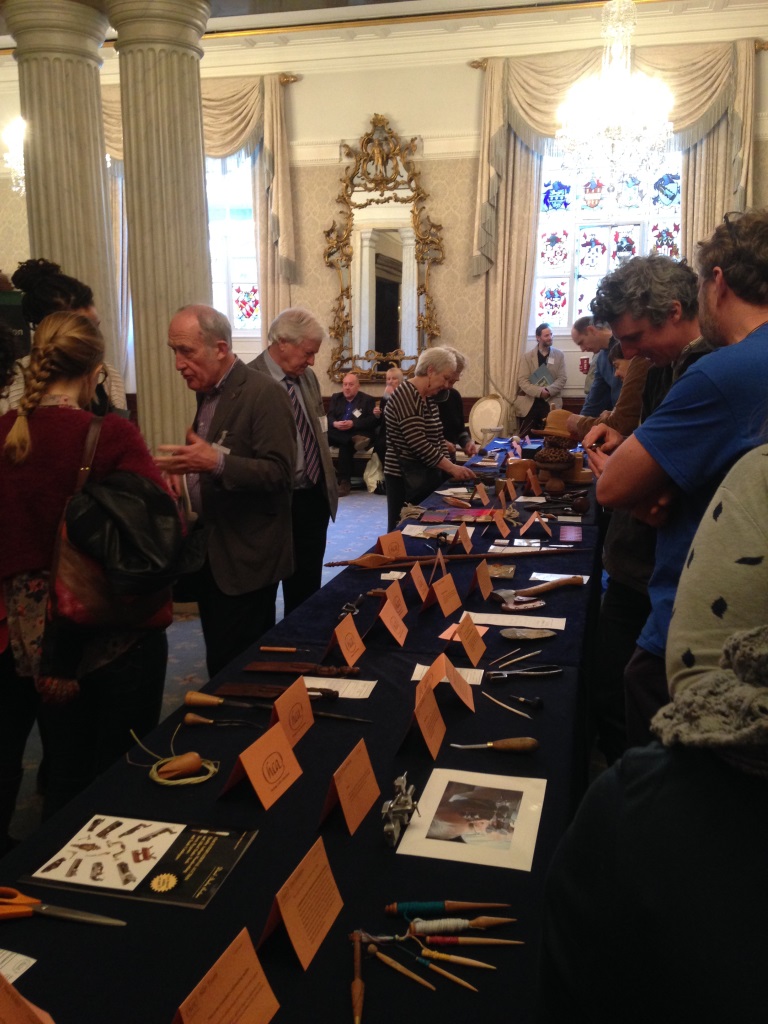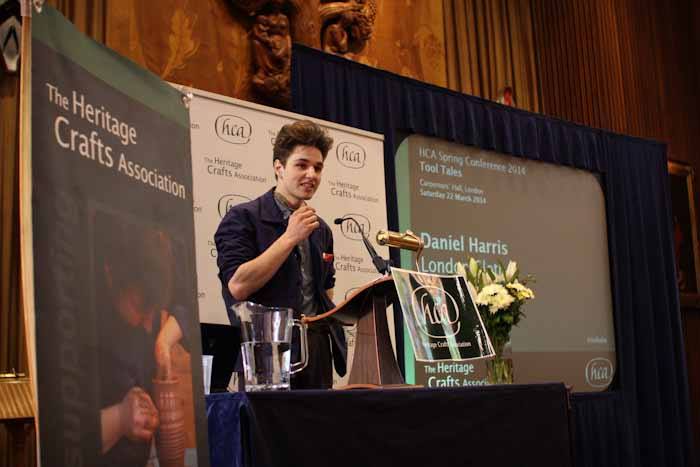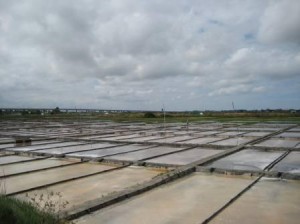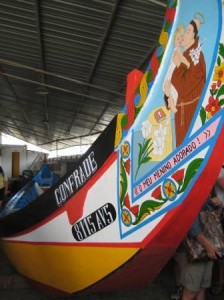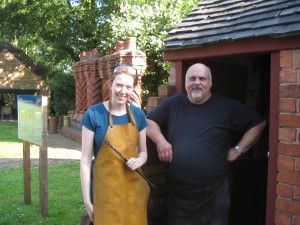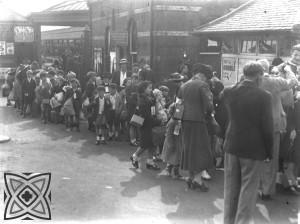Reading Connections
Tool Tales
On Saturday the Heritage Crafts Association held its fourth annual Spring Conference, and this year’s theme was ‘Tool Tales’. What better theme could there be for a craft conference? Almost every craftsperson needs at least one tool – and some need hundreds!
It was a very packed day, with five speakers, an AGM, awards and an instant gallery of delegates’ favourite tools to fit in. Some of my favourite quotes came from Professor Trevor Marchand, who spoke about problem-solving in bench-side learning – ‘craft is problem-solving’ and ‘hand work is intelligent work’ – and Dr Phil Harding in his appropriately titled talk, ‘Getting a Handle on Prehistory’ – ‘a tool with no handle is a useless tool’. And Grace Horne, knife-maker and corset-maker, who described herself as having an extra-marital affair with scissors, reminded us that scissors are so much more than ‘two knives attached by a screw’.
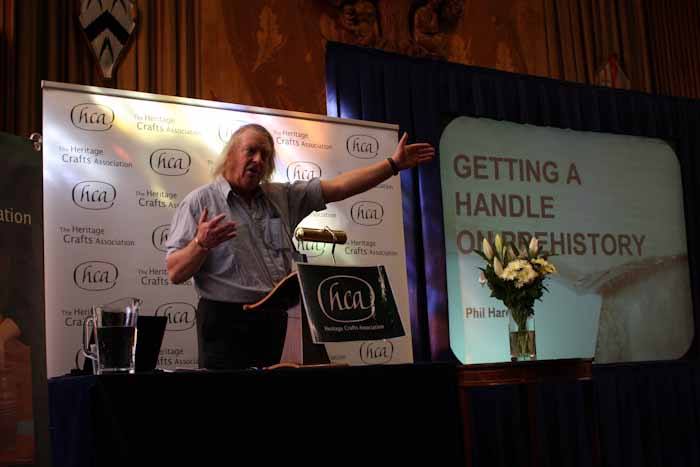
Phil Harding getting a handle on pre-history (which I initially mis-read as ’embroidery’ and was rather confused!)
Daniel Harris of the London Cloth Company made everyone laugh with his stories of spending his days transporting, dismantling and rebuilding large numbers of nineteenth-century industrial looms (there’s always a few pieces leftover – ready to form part of the next loom). And Roger W. Smith wowed us all with his incredible patience and precision – watch-making is a craft that involves 34 separate trades, all of which Roger undertakes at his workshop where they make only eleven watches a year!
In July 2013 the HCA launched its own suite of Heritage Crafts Awards, building on existing awards, and the winners were announced on Saturday. They included local boat-builder Colin Henwood of Henwood & Dean, who won the ‘Maker of the Year’ award. Colin is based in Henley-on-Thames and specialises in the restoration, rebuilding and maintenance of classic wooden Thames boats – and he was recently interviewed by Phillippa, MERL’s Public Programmes Manager, for the oral histories element of the Reading Connections project.
This week I’m setting myself the challenge of getting to grips with social media – and there’s loads out there about Tool Tales. Why not take a look at the HCA Facebook page to see photos from the day, Pinterest to see photos of tools for the instant gallery, and Storify to see some of the tweets about the day.
Happy New Year

P TAR PH3/2/13/3/24. John Tarlton Collection. Black and white photograph entitled Great Frost – as the sun breaks through on New Year’s day the ice glistens on every blade and branch, Exmoor.
Happy 2014 to all of you MERL Projects Blog readers!
I can’t believe how quickly 2013 went (or how long it is since I last did a blog post). The start of a new year is always a good time to look back at what you’ve achieved over the past 12 months, and to look ahead to what you want to achieve in the coming months. Yesterday was my first day back in the office after a lovely break, so I took the opportunity to write a January-February 2014 To Do list – and there’s an awful lot on it!
A Sense of Place: We just managed to enhance 9000 records at the end of 2012, and our current total at the end of 2013 stands at 15805 records. This progress is largely thanks to Laura, who was working on the project for several months over the summer while Felicity and I moved on to other projects (although we did manage to fit in some cataloguing too). This means that there’s only another 3000 records to go until every record has been enhanced – something I’d really like to see done! I’ve also been starting to tidy up (and hopefully massively reduce) the list of object names (and their numerous variants) when I have a spare moment or two.
Countryside21: This has been a bit of a stop-and-start project, and we’ve made really good progress on some elements and virtually none on others. The positives include nearly finishing the Time Based Media survey (I’m aiming to have it signed off by the end of January), renaming thousands upon thousands of files and restructuring the way they’re organised (all Felicity’s work), revising the MERL Classification, rationalising our use of subject keywords in Adlib, and finally beginning to implement the new Classification and the associated keywords (I’ve already managed to do this for 3400 records in the space of two weeks). We’ve also updated the ‘Geographical Keywords Manual’ and will be putting together guidelines on how to use other types of keywords in the coming weeks. The ‘To Do’ list includes selecting and keywording images for commercial purposes, and arranging the technical side of the project such as the Digital Asset Management software and the e-commerce.
Reading Connections: While we don’t blog about the Reading Connections project here (it has a separate blog) this has been occupying a lot of mine and Felicity’s time throughout 2013. We spent the summer photographing 600 of Reading Museum’s Historic World Objects, and since then Felicity has been spending several days a week at Reading Museum researching and writing detailed descriptions of these objects. Meanwhile I’ve been working on cataloguing craft here at MERL and have enhanced/tidied/cross-referenced all of the records for clay, leather, metal, stone, straw and textile crafts, leaving just wood crafts to go in 2014.
Stakeholders: We had a hugely successful two day study visit from ten basketmakers at the start of December to kick the project off. We’ll be photographing all of the baskets we studied in a couple of weeks, and then it’s a case of adding all the new information that we gathered to Adlib, commissioning pieces from the participating makers, and putting together some banners for a pop-up exhibition in the future.
Our Country Lives: While not officially one of Felicity’s and my projects, we’ve both been involved in the plans for the re-development of MERL over the last couple of months of 2013. It’s been a really eye-opening experience and we’re very much looking forward to how it progresses.
Miscellaneous: And as ever, we’ve been working on lots of other bits and pieces too. Our volunteers have continued to scan the 60-series negatives and add them to Adlib. 3000 negatives were scanned in 2013, leaving only another 5 boxes (out of a total of 23) left to do. I’ve been adding any existing colour photos to Adlib which for some reason weren’t already on there – I’ve done the 1970s, 1980s, 1990s and 2000s, leaving just the 1950s and 1960s to go.
So, all in all, a very busy year just gone (with much more than I’ve managed to mention), and another busy year to come (again, with much more than I’ve managed to mention)! But, at least I can say that I’m really looking forward to 2014 here at MERL and all there is to do. Wishing everyone all the best for 2014!
Fitching, pairing, randing, slewing, waling….

MERL 70/149. A ‘malt skep’, used at Warwick & Richardsons Brewery in Newark-upon-Trent for moving barley from the cistern to the working floor and green malt from the floor to the kiln. The ropes are for dragging the skep across the malthouse floor.
This week I’ve started thinking about how best to record the information that we gather during the project. I’ve been exploring the functionality of Adlib, our collections database, to see what sort of things we can record and where. Adlib has specific fields for ‘materials’ and ‘techniques’ which we don’t currently use – these are something I want to experiment with during Stakeholders (which might also benefit other work, such as the craft cataloguing for another project I’m working on, Reading Connections). The advantage of these fields is that they are searchable and, because they are terminology-controlled, the terms used can be standardised.
I’ve also been thinking about how to record some of the more detailed information that we’ll hopefully gather. My current thoughts are to complete a detailed recording form for each basket which can then be attached to the database record, in a similar manner to Dorothy Wright’s ‘Catalogue of Baskets’ forms, but hopefully with slightly more detail. We could fill in everything we already know, add to it during the workshop visit, and circulate to participants afterwards for them to check and add any additional information. However, this wouldn’t be searchable as an attachment but it would mean that the information was there – I need to discuss this idea with Ollie and see what he thinks.
I’ll also need to think about how to record more general and perhaps tangential information that will inevitably emerge – things like memories and reminiscences, makers’ personal experiences, related photos and films etc.
I’ve also been taking advantage of the MERL Library to look for basket-related books and have started to compile a list of key terms – focusing on materials, techniques, and names for parts of a basket. So far, I’ve been through the Basketmakers’ Association’s list of terms, Mary Butcher’s Willow Work, and Sue Gabriel and Sally Goymer’s The Complete Book of Basketry Techniques. If anyone has any other recommendations, or knows of any good existing lists of terms, please let me know!
Sharing Cultures 2013

The conference took place in the city’s cultural centre, which is housed in an amazing red brick building which was formerly a ceramics factory.
Last week I was lucky enough to represent MERL and the Heritage Crafts Association at Sharing Cultures 2013, an international conference on intangible cultural heritage (ICH), held in the city of Aveiro in Portugal.
Usually, whenever I tell people I’m interested in intangible heritage I get a blank look and have to explain what I mean – so, what is ICH? Normally, when we think of cultural heritage we think of tangible, physical things such as buildings, monuments, sites and museum objects. The concept of intangible cultural heritage recognises that there are many non-physical things which are also a part of our heritage. This concept was formalised by UNESCO in its 2003 Convention for the Safeguarding of the Intangible Cultural Heritage, which set out five domains of ICH – oral traditions and expressions; performing arts; social practices, rituals and festive events; knowledge and practices concerning nature and the universe; and traditional craftsmanship.
There were two days of parallel sessions on the five domains of intangible heritage, plus sessions on education and ICH, musealisation of ICH, and safeguarding and managing ICH. I gave a paper on craftsmanship as heritage in the UK, using basketry as an example craft to explore ideas of applying values-based approaches usually used in the management and safeguarding of tangible heritage to intangible heritage, and looked out how such an approach can inform the work of the HCA.
There was also a day of workshop visits to see local expressions of intangible heritage in the Aveiro region – including visits to see the making of ‘ovos moles’ (a traditional Portuguese sweet), salt harvesting at the city’s ecomuseum, traditional painting of ‘moliceiros’ boats, and an ethnographic museum with demonstrations of traditional skills such as basketmaking, netmaking, plant-grafting, and adobe brick making. Read more about the visits on the HCA blog here.
Various papers caught my attention for different reasons – in my work at MERL, in my HCA capacity, and for my own personal interest – although there weren’t as many papers on craftsmanship as I would have liked! Some of the musealisation papers were of particular relevance to ideas we’ve been exploring in some of the projects at MERL, particularly one by Ferenc Kiss on the use of new technologies for providing multimedia interpretation experiences not only in museums but out and about, making use of smart phones, QR codes (which we’ve briefly experimented with in A Sense of Place), and other multimedia functions. There was also a paper by Sabine Marschall about a project called eNanda Online, a website for digitally recording and sharing oral history and living cultural heritage of a Zulu community in South Africa (which may relate to some of the work we’ve been doing on Reading Connections). Read more about the papers on the HCA blog here.
All in all it was a fascinating conference and it was great to have the chance to meet other people who are interested in and involved in ICH work.
Where has July gone?!?!
Felicity and I have been working on so many different and exciting things recently that we’ve got a bit of a blog-backlog, so I thought I’d give you a quick update on some of the things we’ve been up to (and hopefully more detailed posts will follow when we get a chance).
At the beginning of July, Felicity and I went on a one-day blacksmithing course at Avoncroft Museum near Bromsgrove as part of our bid to try out different crafts so that we have a better understanding of them and can catalogue them more accurately. We both made beautiful pokers – and the glorious weather we’ve been having recently has given us a chance to test them out on the BBQ.
The following week, we had two days of photography training at Reading Museum’s store – learning all about lenses, apertures, shutter speeds, focusing and so many other things – and then began photographing their 600 shortlisted Historic World Objects as part of the Reading Connections project.
Last week, six of us were lucky enough to go to Sweden (generously funded by ERASMUS) to visit the Nordic Museum and Skansen (one of the world’s oldest open air museums) in Stockholm. We also had a chance to visit the Gustavanium at the University of Uppsala. The main purpose of the visit was to exchange ideas and inform plans for future development at MERL – but we all had our own areas of focus. Felicity was concentrating on the presentation of ethnographic material, particularly relating to the Sami, while I was looking at how craft was represented.
This weekend, Felicity attended an international conference at the Pitt Rivers Museum in Oxford (thanks to funding from the PRM and Oxford ASPIRE) on the topic of The Future of Ethnographic Museums. She gave a poster and presentation on the work of A Sense of Place and its links to museum ethnography. (Ollie has written an interesting post for the Our Country Lives blog about how the ethnographic discourse relates to MERL.) The conference was the culmination of a five year project funded by the European Commission called Ethnography Museums and World Cultures.
And this week (thanks to funding from ERASMUS and the HCA) I’m attending Sharing Cultures 2013, an international conference on intangible heritage, where I’ll be presenting a paper on basketry as heritage in the UK. The conference includes a day of workshop visits, and also has sessions on intangible heritage and traditional craft, and intangible heritage and museology, all of which I’m really looking forward to.
In the meantime, Laura has been doing a fantastic job with enhancing object records and giving them the ‘Sense of Place treatment’. She’s well on her way to getting us to the 1970s – at which point we’re planning a celebration 1970s style!
So there’s plenty to blog about and hopefully you’ll hear more about all of this soon.
Introducing Laura
I’d like to introduce our readers (rather belatedly) to Laura, who joined A Sense of Place at the end of April for five months. She’s taken over cataloguing as Felicity and I moved onto our other projects, Countryside21 and Reading Connections, and she’s been doing an amazing job so far! It’s so good to know that the cataloguing is carrying on, even though we’re no longer working on it – having a detailed and accurate, easily searchable catalogue makes such a difference to all aspects of museum work! As well as enhancing the records and continuing the work of A Sense of Place, Laura will also be helping to answer object-related enquiries and blogging – look out for a post from her soon.
The MERL Classification
Apologies for the recent lack of blogging – Felicity and I have been spending quite a lot of time at Reading Museum recently as part of the new joint project between MERL and Reading Museum, Reading Connections. I promised a long time ago to write about a post about the MERL Classification, which we’re reviewing and updating as part of Countryside21, and which we hope will be a starting point for developing new ways in which to keyword our collections.
Until the start of Countryside21 I had never paid much attention to the Classification and how, or why, it was used. As part of the review process, I have been looking into the history of the Classification to understand how it came about and how it has evolved over time.
Classification systems are used by museums to organise data about their collections. The MERL Classification was devised by John Higgs, the first Keeper at MERL, specifically for the circumstances at MERL and was determined by the nature and content of the object collections. It was informed by existing classifications at the time, such as those used by the National Museum of Denmark, the Welsh Folk Museum and the Royal Anthropological Institute. The Classification was based on the idea that MERL is a folk museum and deals primarily with people and their lives, rather than with objects. As a result the classification of an object is driven by its sphere of use. It was initially used for the Object Collections, and later expanded to the Photographic Collections (photos of objects are classified according to their sphere of use; other photos are classified according to their subject content).
The MERL Classification was built on the premise that a classification should be as simple as possible, with the caveats that it must be workable and must bring material together in the right groups. It originally had 24 primary headings, which could be sub-divided into secondary, tertiary and quaternary headings, each with a numerical notation. The Classification was intended to grow and develop with the expansion of the collection, with new divisions being created only when an accumulation of similar items made it clear what the heading should be. By 1978 the Classification had expanded to 33 primary headings. A review in the 1990s reduced this down to 31, and today the Classification is only used for objects – it is no longer used for photographs.
The review work on the Classification is nearly complete. This has involved consulting the wider rural museums sector to see if there are any institutions still using the MERL Classification (it has always been publicly available); considering how it compares with the Social History and Industrial Classification (SHIC) used by many other rural museums; and looking at how we can streamline the primary headings. Hopefully, we will be making some final decisions tomorrow, and will be publishing the revised Classification in due course.
A new project and a new blog: Reading Connections
If you’ve seen any recent news updates from the Museum you might know that MERL was recently awarded funding from Arts Council England for a major project in collaboration with Reading Museum, called Reading Connections.
The project started in April, and we’ve got lots to tell you about the different things that are going to be happening. There are a number of themes to the project, including world cultures, local collections, craft, and Reading in conflict. This will include collections work and engagement, including events, exhibitions and online resources. In particular there will be a series of events to commemorate the centenary of the start of WWI in 2014. But I shan’t go any further here – to find out more, go along to the Reading Connections blog. (There’s a separate blog for this new project to reflect that fact that it is a partnership with Reading Museum.) If you’ve enjoyed following this blog (which will continue to run, don’t worry!), do take a look at Reading Connections, and see what’s happening!




